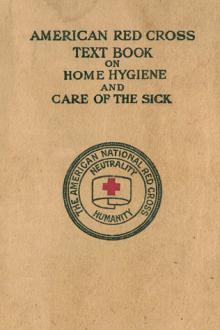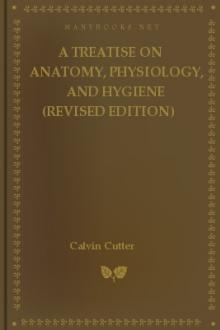American Red Cross Text-Book on Home Hygiene and Care of the Sick by Isabel McIsaac (best affordable ebook reader txt) 📕

- Author: Isabel McIsaac
- Performer: -
Book online «American Red Cross Text-Book on Home Hygiene and Care of the Sick by Isabel McIsaac (best affordable ebook reader txt) 📕». Author Isabel McIsaac
Medicines to stop pain or to induce sleep are probably the most pernicious of all self-prescribed remedies, for they add to other dangers the possibility of forming drug habits. These habits are so insidious and so powerful that it is not safe to take habit-forming drugs even once except by a doctor's direction. In short periods of time strong people, apparently firm in will and character, have acquired habits from supposedly moderate use of drugs like morphine, cocaine, and alcohol. No one, no matter how sure of his own self-control, can afford to run so grave a risk.
—Objections to self dosing in general apply even more strongly to using patent medicines. The ingredients of patent medicines are ordinarily unknown, so that using them is unintelligent at best. Sometimes they contain habit-forming or other harmful drugs. In other cases the ingredients are innocent enough, but totally unable to bring about the results claimed for them. The old story about a powerful remedy discovered by accident and thus unknown to the medical profession deceives only the ignorant or credulous; with our present knowledge of chemistry and physiology powerful remedies are not discovered in that way.
Even to these comparatively harmless patent preparations there are two serious objections. One is the loss of time, during which the patient may grow worse. The other is that money is obtained under false pretenses; fraud is a common element in the success of patent remedies. One of the least harmful, a substance called "Murine" may be taken as an example[2]. This substance was widely advertised at one time as a "positive cure for sore eyes." Analysis showed it to be a solution of borax, which cost about five cents a gallon to prepare. It sold for one dollar an ounce, or at the rate of $128.00 a gallon. Although it could not bring about the wonderful cures advertised, it was practically harmless, and buyers of "Murine" must have been injured chiefly in pocket. But with "cancer cures" and "consumption cures" it is a different story. Early treatment of these diseases is essential to recovery; delay in many cases means robbing the sufferer of his only chance of life. No drugs are now known that will cure these diseases, and it seems incredible that anyone should be willing to practise such cruel deception upon ignorant people merely for the sake of making money.
—Medicines may be introduced into the body in a number of ways. In the majority of cases they are swallowed and finally carried to the tissues by the blood just as digested food is carried.
Except in rare emergencies no medicine should be given to a sick person without the doctor's order. The prescribed dose should be accurately measured in a medicine glass having a scale to show the number of teaspoonfuls. When measuring medicine, think only of what you are doing; neither talk nor listen to conversation. First read the label on the bottle. Next, shake the bottle, if the medicine is liquid, in order to mix the contents thoroughly. Then remove the cork with the second and third fingers, and hold it between them while pouring, thus keeping the cork clean and protecting the contents of the bottle. Hold the medicine glass on a level with the eyes, and in the other hand hold the bottle, with the side bearing the label uppermost to avoid soiling it; pour out the dose, measuring exactly, wipe the bottle, replace the cork, and again read the label on the bottle.
Most medicines should be diluted with a little water. Pills and capsules should not be presented to patients in the attendant's fingers, but on a saucer or teaspoon. Acids and medicines containing iron should be taken through a glass tube kept for medicine exclusively. Tubes and glasses should be washed at once after use, and neither they nor the bottles should stay in the patient's room. If a dose is omitted for any reason, do not increase the next dose; give the regular dose at the next regular time.
Serious mistakes in giving or taking drugs are far too common, and no precautions are too great to guard against them. Never use medicine from a box or bottle that has no label. Never take or give another person a medicine selected in the dark, even though you have positive knowledge that there is no other bottle or box of medicine in the whole house; in just such circumstances the fatal mistakes occur.
A few things can be done to make medicines more palatable. The water used to dilute the dose and to be taken after it should be very cold. Holding the nose is helpful. A piece of cracker, a peppermint, or a slice of lemon or orange, if allowed, may be taken afterward. Giving disagreeable medicine in ordinary food, as lemon juice, orange juice, or milk, and giving bitter powders in jam or jelly, is unwise because it sometimes results in life long dislike for a useful article of diet. Where food is given directly after the dose to take away its taste, the association of dislike seems to be formed less frequently.
The taste of castor oil is so disgusting that it often causes vomiting, but if skillfully given the oil need not be tasted by a patient who is willing to coöperate. Its way of sticking to the tongue and teeth constitutes the chief difficulty; the object therefore is to prevent it from sticking by swallowing the dose all at once. To administer the oil, wet the inside of a medicine glass or large spoon with very cold water, and leave a little water in the bottom. Pour the required dose in slowly and cover it with more cold water. Let the patient hold in his hand something to take away the taste,—cracker, bread, peppermint, or whatever is allowed; for castor oil water is not very effectual. Then direct him to hold his nose, open his mouth, and hold his breath; caution him to let the oil run down without swallowing until all has been taken, and afterward to chew the cracker, continuing to hold his nose until he has swallowed the cracker. When the patient understands and is ready, pour the dose in quickly as far back as possible, taking care not to spill the last drop on the lips. This process may seem unduly troublesome, but when castor oil is needed it is badly needed and efforts to make it stay down are worth while. The following method also effectually disguises the taste of castor oil: place in a glass a teaspoonful of baking soda, add the prescribed dose of oil and then the juice of half a lemon. Mix all together thoroughly and let the patient take the mixture while it is effervescing. This method may be used unless the patient is not allowed soda and lemon juice. Castor oil may be bought in capsules, but on account of their size many people find the capsules impossible to swallow.
—Sometimes medicines are given through the rectum. For this purpose they are combined with cocoa butter or other material, and made into small cones called suppositories. They melt at a low temperature and should be kept on ice until needed. A suppository should be lubricated with vaseline, and inserted very gently as far as the finger can be introduced, while the patient is lying on the back or left side.
—An injection of a fluid into the rectum is called an enema. (Plural, enemas, or enemata.) Enemas are generally used to cause evacuation of the bowels.
For a simple purgative enema one of the following is generally used: plain water; or a solution of common salt in the proportion of one teaspoonful of salt to one pint of water; or soap suds made with a white soap such as castile or ivory. Unless otherwise ordered the temperature of the enema should be between 105° and 110° F.
To give an enema, one should proceed as follows: First protect the bed by placing under the patient's hips a rubber sheet, covered by a draw sheet or large towel. Let the patient lie on the back, with the knees flexed and head low. Bring to the bedside a commode or bedpan, and lastly the solution contained in a fountain syringe having a long rubber tube, stopcock and short hard rubber nozzle. The bag of the syringe may be hung on the bed post or elsewhere, but it should not be more than three feet at most above the patient's head. Lubricate the nozzle with vaseline either from a tube, or removed from a jar by means of a piece of toilet paper; never dip the nozzle itself into a vaseline jar. Let the solution flow into the bedpan until it runs warm and smoothly; a jerky flow means presence of air bubbles which cause pain if injected into the bowels. Unless the patient is able to do it herself, gently insert the nozzle, and at the same time start the flow. Force must not be used in inserting the nozzle, and the flow should be gentle; if the solution goes in rapidly the patient may be unable to retain it. If there is a desire to expel the enema as soon as the injection has begun, shut off the current and wait a minute, meanwhile making gentle pressure upon the patient's abdomen with one hand; then lower the bag a little and begin again. A grown person should take from two to four pints, and a child from one to two pints. After the enema is finished give the bedpan immediately; the enema will, however, be more effective if retained a few minutes. The bedpan should be given and removed according to the directions on page 176. Sometimes an enema is expelled with such violence that it soils the upper sheet; to protect the covers a rubber sheet may be spread over the patient's knees and legs. Since an enema sometimes causes nausea or faintness, a patient should be watched constantly during the process.
To give an enema to a baby one may use a small syringe having a soft rubber bulb with a nozzle directly attached, or the ordinary fountain syringe with the small, hard rubber tip designed for infants. The enema should be given in a warm room free from draughts, and the baby must be warmly covered throughout the process. First cover the lap with a pad or folded blanket. Upon the blanket place a warmed rubber sheet, and over the rubber a warm diaper. Hold the baby on your lap, so that he lies on his back with his knees drawn up. Hold his feet or legs firmly in your left hand. Lubricate the nozzle thoroughly with vaseline. Be sure that all the air is expelled from the syringe, and then proceed as already directed. A baby will take from two or three ounces up to half a pint or even more, according to the size of the child. After the injection is finished place a small vessel under the baby's hips, and hold it until the fluid has been expelled, keeping the child well covered all the time.
After being used, the nozzle of a fountain syringe should be washed with soap and water, boiled, dried and put away in a clean place. Inserting the nozzle into the bag of the syringe immediately after withdrawing it from the rectum is a filthy but not uncommon practice. The syringe should be kept clean inside and out; it should be washed in hot soapsuds, rinsed





Comments (0)